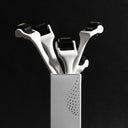So you just had your hair transplant, and someone told you to use minoxidil after a hair transplant. You're feeling confused, isn't that the point of hair transplant? To not use minoxidil?
Well, here's why they said that and some important considerations before you use it. We'll go over the reasons against, for and other questions regarding minoxidil after hair transplant.
Table of content
Why shouldn't you use minoxidil after a hair transplant?
Some of these reasons include:- Healing period: In the initial weeks following a hair transplant, the surgical site needs time to heal properly. Applying minoxidil too early can potentially cause irritation, inflammation, or interfere with the healing process. It's essential to wait until your surgeon gives you the go-ahead to start using minoxidil.
- Adverse reactions: Some people might experience side effects from using minoxidil, such as itching, redness, or dryness. In more rare cases, minoxidil can cause more severe side effects like dizziness, chest pain, or rapid heartbeat. If you have a history of adverse reactions to minoxidil, your surgeon might advise against using it after your hair transplant.
- Pre-existing medical conditions: Certain medical conditions or medications may interact with minoxidil, making it unsuitable for some individuals. It's crucial to discuss your medical history and any medications you're taking with your surgeon or healthcare provider before using minoxidil after a hair transplant.
- Alternative treatments: Your surgeon might recommend alternative treatments or medications, such as finasteride or other hair growth supplements, that they believe would be more effective or better suited for your specific situation.
It's essential to follow your surgeon's advice and instructions regarding post-operative care and the use of minoxidil or other hair growth treatments.
Always consult your surgeon or a medical professional if you have any concerns about using minoxidil after a hair transplant.
As your leading source for hair health information over the past 4 years, we never compromise on accuracy. When it comes to your health, you deserve information you can truly rely on - and earning your trust is our top priority.
Here's how Scandinavian Biolabs ensures every piece of content meets the highest standards of accuracy and integrity:
- Credentialed Experts: Our reviewers are actively practicing doctors and medical researchers
- Stringent Reviews: Content undergoes rigorous editing by subject specialists and review by a practicing doctor.
- Evidence-Based: We rely on well-established research from trusted scientific sources like peer-reviewed journals and health authorities.
- Full Transparency: Our editorial standards, writer credentials, reviewer credentials, correction process, and funding are all publicly documented.
- Independent Voice: While we do promote products, we operate in a vacuum to business operations. Our main goal is just an unwavering commitment to providing medically-sound guidance.
You can count on Scandinavian Biolabs to consistently deliver the trustworthy health information you deserve. Read our Editorial Standards.
Why should you use minoxidil after a hair transplant?

Grow transplant hair
Most people are surprised to learn that hair transplant surgery is just the beginning of the hair growth process. To ensure that transplanted hair follicles take root and begin to grow, patients must take a medication called minoxidil.
For best results, patients should use minoxidil as directed by their surgeon. With regular use, minoxidil can help maximise hair transplant surgery's effects.
Stop shock loss
After the surgery, it is common for patients to experience what is known as "shock loss." The transplanted hair disappears, leaving the area looking thin and patchy. Minoxidil is a medication that helps to prevent shock loss and encourages new hair growth.
It is available in a liquid and foam formulation and can be applied directly to the scalp. Minoxidil is usually used for three to six months after surgery to see results. However, some doctors may recommend a longer course of treatment.
While minoxidil is generally safe, it can cause side effects such as itching, redness, and irritation. For this reason, it is mandatory to consult with a doctor before using this medication.
Control expected hair loss
Anyone who has undergone a hair transplant knows that the surgery is only half the battle. To ensure that your new hair follicles take root and flourish, it is essential to follow your doctor's post-operative care instructions to the letter.
One of the most important things you can do is to use minoxidil ( Rogaine) as directed. Minoxidil is a medication that helps to promote hair growth and prevent further hair loss. It is typically used once or twice a day and should be applied directly to the scalp.
While applying another medication to your already-sensitive scalp may seem like a hassle, using minoxidil as directed is essential for achieving the best possible results from your hair transplant.
Is there an alternative to minoxidil?

Why yes there are!
With the list of side effects and the fact that you have to use minoxidil indefinitely to see results, people are more often than not discouraged by this drug.
They start to seek out alternatives.
Understanding that, we made a list of only the best alternatives to minoxidil on the market right now.
When can you start using minoxidil after a hair transplant?
Typically, you can start using minoxidil 2-4 weeks after your hair transplant surgery, or as directed by your surgeon. It's important to wait until the surgical area has healed, and there is no crust, redness, or irritation.
When to stop minoxidil after hair transplant?
The duration of minoxidil use after a hair transplant varies from person to person and depends on the individual's response to the treatment. Some may continue using minoxidil indefinitely, while others may stop after several months or years. Consult your surgeon or dermatologist for specific recommendations based on your hair growth and progress.
Where to apply minoxidil after hair transplant?
Apply minoxidil to the scalp in the areas of hair loss or thinning, as well as the transplanted area, unless instructed otherwise by your surgeon. Make sure to follow the product's instructions and your doctor's recommendations for proper application.
Will minoxidil work?

While minoxidil is generally safe after hair transplant surgery, there is no guarantee that it will be effective.
This is because minoxidil stimulates blood flow to the hair follicles, and the new strands created by surgery may already receive adequate blood flow.
As a result, patients should speak with their doctor before using minoxidil after hair transplant surgery.
What is minoxidil?

Minoxidil is a medication that is used to treat high blood pressure. It is also used to promote hair growth in balding people. Minoxidil was first developed as a treatment for high blood pressure. It works by expanding blood vessels, which lowers blood pressure.
Minoxidil was first sold as the brand-name drug Loniten. It is now available as a generic and over-the-counter (OTC) medication. Minoxidil is also sold under the brand names Rogaine and Regaine. Minoxidil is applied to the scalp twice daily to stimulate hair growth in balding people.
You can use minoxidil once a day, if you're feeling lazy - but there's a catch.
There are two forms of minoxidil, minoxidil foam and liquid.
It should be used indefinitely to maintain new hair growth.
Minoxidil is an FDA-approved medication for hair loss in men and women. It is safe and very effective when used as directed by your doctor or pharmacist. Talk to your doctor about whether minoxidil is suitable for you.
Reference
https://www.ncbi.nlm.nih.gov/pmc/articles/PMC6691938/
Read more:





